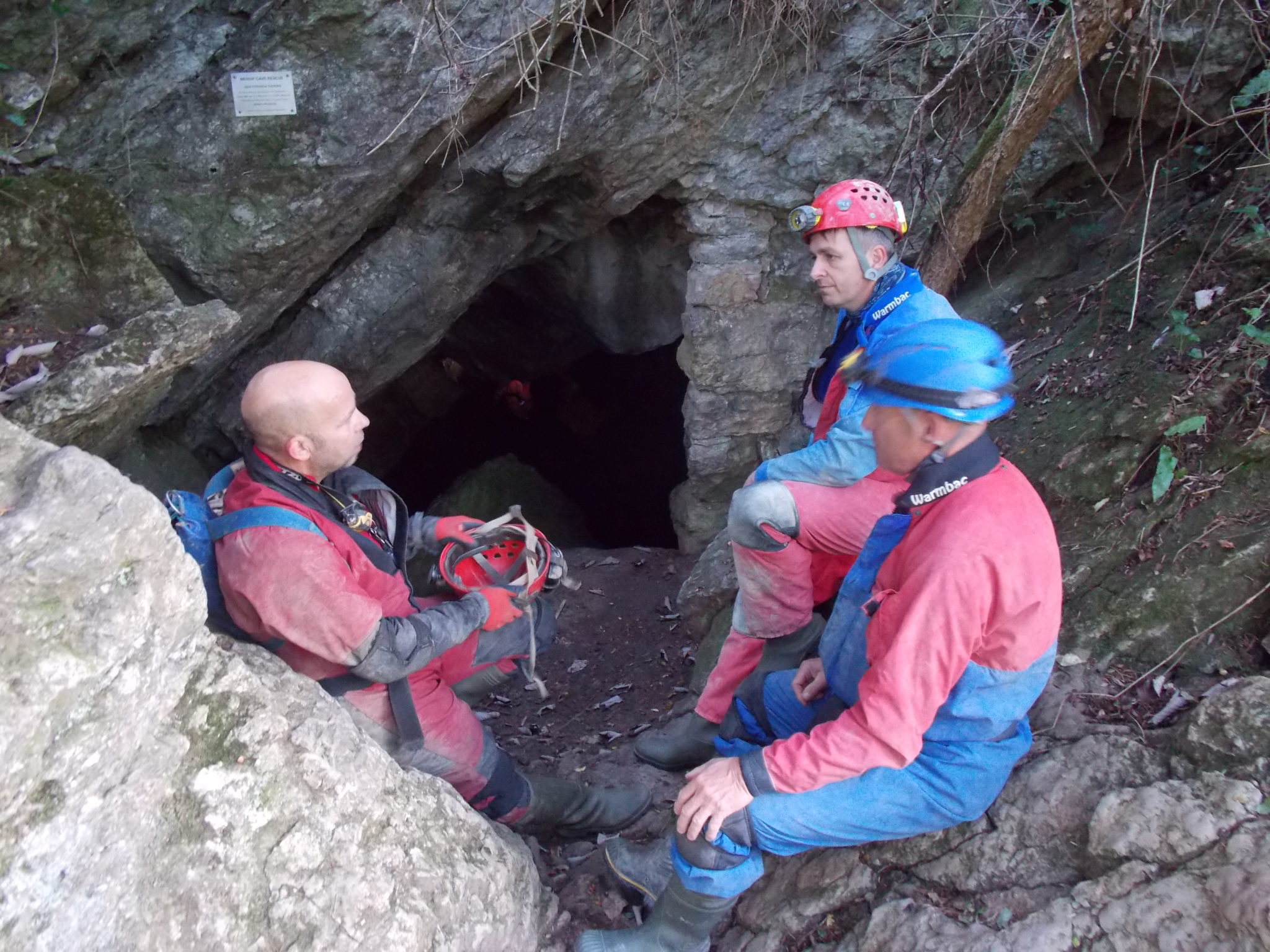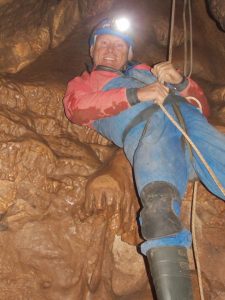
It had never really occurred to me that caving instruction could be so enjoyable and simple to arrange. In the summer of 2016, I attended a meeting of the Council of Southern Caving Clubs, to represent my club, the Wealden Cave and Mine Society. This is a very rare event for the club – the last time this had happened was many years previously. The meeting was well-attended, and the CSCC Training Representative, Chris Binding, raised the matter of lack of club participation in the BCA-sponsored Recreational Training Scheme. It was when Chris mentioned that the nature of the training was very much up to the organising club to decide, and that there was no rigid agenda that had to be followed, that I started to see the value of the scheme for ordinary cavers. And to be perfectly honest, I was barely aware of the scheme before this, if at all.
A chat with Chris confirmed that the scheme would indeed suit WCMS members very well, since I had in mind that new cavers or those with little caving experience would benefit from some simple but important instruction on understanding the cave environment, staying safe within a cave, protecting the cave, and all those things that cavers of many years’ experience assume they have assimilated over the years.
Many club cavers assume that this is the sort of simple stuff that clubs arrange for their own members. But, when I asked myself whether this was really true for WCMS, I had to admit that we had nothing in place other than including new members on normal trips and keeping an eye on them. As I was to discover when the training actually took place, the information that can be passed on during a proper course far exceeds what any new caver would pick up over a dozen or more caving trips. And, were a club to set up a permanent training regime for new members, it would require the dedication of a small group of experienced cavers – probably the same ones that always step forward to do things – to set it up and run it, and to be brutally honest with ourselves, most cavers would rather just go caving – that’s why they joined a club in the first place.
So to use a properly accredited caving instructor to teach cavers the simple skills needed to enjoy caving in a safe and proper way seemed like an option that needed to be explored, and Chris was the obvious person to approach. We reserved a weekend in the diary, of September 24th and 25th, and I put out a circular to all members to promote interest. I was specifically promoting the weekend as an introduction to caving for new cavers, or those who felt they might benefit from such an approach.
The immediate response was encouraging, with five members putting their names forward. One person subsequently had to drop out, and another turned out to have lapsed membership. Nevertheless, another person came forward, and with my name on the list we were back up to five again. I was not expecting to pick up a great deal from the event, but would take on more of an observer’s role.
The event started on a bright and dry morning in Burrington Coombe. Chris chose Goatchurch Cavern as a suitable location to get to know the group, and to cover the first principles of caving safely. Outside the cave, in front of the Mendip Cave Rescue advice plaque, Chris emphasised the importance of a call-out for every caving trip, and also the importance of making sure that anyone acting as your call-out knows who to call, what to tell them, and what to expect from the emergency services.
Once inside the cave, we were immediately advised that caves accepted by many people as “easy” or “novice” caves do contain dangers and risks, and we should always be aware of them, and never assume that “easy” caves equate to “safe” caves. Decades of heavy use of Goatchurch Cavern have left a smooth polished floor, making the cave quite prone to slips and falls for the unwary. It was therefore quite appropriate that it was here that Chris introduced the group to the proper use of ropes to ease the safe descent of slopes and short drops. We found a corner just away from the through traffic of a number of led groups, and here we learnt about the different diameters of ropes used for caving, how to look for a good belaying point, how to select and use an artificial belay such as a P-hanger, and what to look for in a natural belay, and how best to judge its suitability.

I was beginning to take a more active interest in the dialogue by this time, as increasingly, Chris was pointing out things that perhaps I should have been more aware of, despite many years of caving under my belt. It was now that things started to become more “hands on”. We were taken through the tying of three basic caving knots, the figure of eight, the bowline, and the Italian hitch. We were also shown the suitability or otherwise of steel and aluminium karabiners, and the risks tragically learnt not so long ago connected with the use of snaplink devices. Chris had with him a karabiner I hadn’t come across before, which has two sprung gates, one which opens inwards and one outwards. These twingate karabiners, we were told, are far safer than single gated snaplinks as they cannot be accidentally opened when attached to metal hangers, something which has happened with tragic results, but can be rapidly operated with one hand.

We spent quite a while tying knots, rigging handlines, and practicing their use, and although this might sound a little intimidating to someone who might be trying this for the first time, Chris made it entertaining, and we spent as much time as we needed until the group could rig a line and use it with some confidence. We rigged off a single natural belay using a “quick bowline”, then off two natural belays, using a couple of bowlines, and adjusted the rig to suit loads from different directions. We were not only shown how to lock off the knots we were tying, but also told WHY this is done, and with a very simple demonstration of how dangerous a knot becomes when it slowly comes undone after being used at the end of a lifeline a number of times if it is not kept tightly done up by a security knot.

As well as simple handlines and lifelines, we also played with assisted lines when aiding a tired caver up a slope, and we improvised harnesses using a simple web sling, after first being shown what the signs of excessive wear to look for in any PPE equipment fabricated using webbing. Before leaving the cave, we rigged a short abseil off a couple of natural belays at the top of the Coal Chute, and lowered ourselves down using an Italian hitch. Once down, we spoke a while about the importance of having a back-up light, what to use as such, and how to carry it so as to be immediately to hand, even in the most awkward of situations. The dangers and risks of solo caving were covered, and how even when with other cavers, there are situations when you are effectively “solo” caving at times when nobody could possibly provide immediate assistance, such as halfway up a rope pitch.
We left the cave and made our way to the Wessex Cave Club, where, after a quick snack, we walked to Swildon’s Hole across the fields to put the various techniques we had practiced into use. Using the Wet Way into the cave, we used a simple pull-through handline to descend into the stream at one spot, and then we made our way up the Water Rift to the head of the old Forty Foot Pot. Chris was limiting the visit to the Upper Series on account of the slightly elevated carbon dioxide levels present in the cave. Nevertheless, the trip proved to be more than adequate a place to practice the techniques we had gone through in Goatchurch Cavern. Descending the Forty Foot Pot and climbing back up the Water Rift allowed us to rig a safe pull through improvised abseil. The descent was achieved with an additional safety line, which gave an opportunity not only to try using an improvised harness, but also to lifeline someone down a significant drop.
We made our way up into the Old Grotto. This was a fitting location to chat about how caves form, and what creates the calcite mineral deposits of which there are many to be seen in Swildon’s Hole. After we had sat for a while, we covered the problems of hypothermia, the signs to look for, particularly early self-diagnosis, and what to do and not to do if one of your group becomes incapacitated by the condition. Chris got out a survival bag, and demonstrated that the vast majority of cavers probably do not know how to use one properly. I was then placed properly in one while the lesson continued! I felt like the noisy parrot silenced by a blanket placed over my cage.

As we could feel the slightly elevated levels of carbon dioxide, Chris took us through the signs we might notice in a group were the levels to be higher, and the dangers of having a fixed agenda on caving trips, such that the target of the trip becomes more important than the safety of everybody on it. Adapting the trip to suit the conditions and the capabilities of the individuals is very important, bearing in mind that both can change from one minute to the next.
We also looked at survey interpretation, cave navigation, and use of a compass.
I will most definitely recommend that more members from my club attend any future similar training events as I believe that the majority of cavers, regardless of experience, will learn something to improve and enhance their future caving.
Finally, I would like to thank Chris for raising the profile of the BCA scheme, and for providing a great training experience for us.
For more information about the scheme, visit the BCA website at: BCA Recreation Training Grants
